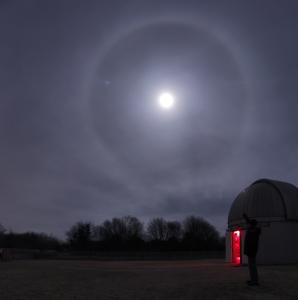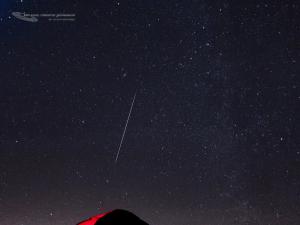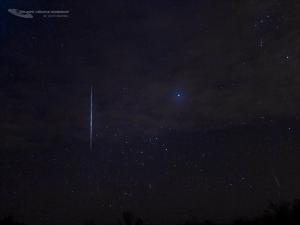
Public Stargazing
- Where:
- Frosty Drew Observatory
- When:
- Friday December 5, 2014 at 6:30 p.m.
- Cost:
- $1 Suggested Donation per Person
Tonight's forecast is calling for cloudy skies, fog, wind, and showers. The bright 99% waxing gibbous Moon will be with us all night as we approach tomorrow night's full phase. We plan to open the Sky Theatre and Observatory at 6:30 p.m. - 9:00 p.m. In the Observatory, telescopes will remain closed and tours will be available. In the Sky Theatre we will be giving a commentary on general astronomy while viewing a slide show showcasing astrophotos shot at Frosty Drew Observatory.
We have had an excellent few weeks and what better night to bring the clouds then the almost full Moon. Come out and check out our gear, operations, and have a friendly informal discussion on general astronomy and the state of all things awesome in space!
-------------------------------------------------------------------------
Weekly Happenings
Scott MacNeill
Next Saturday night (December 13) gear up for a fabulous night of shooting stars and frigid temps as the fabled Geminid Meteor Shower peak is coming to the skies over planet Earth. Producing upwards of 120 meteors per hour under perfect conditions, sky watchers are continuously mesmerized. This year, the third quarter moon will rise around 11:30 p.m. offering fantastic opportunities to catch a stunning display of meteors earlier in the night. Clear your schedule because the Geminid shower is surely one of the best, if not the best, meteor showers of the year.
Unlike most meteor showers, that originate from comets, Geminid meteors originate from the asteroid: 3200 Phaethon. The meteor spewing asteroid was discovered on October 11, 1983, is only 3.17 miles in diameter and has a 1.4 year orbital period around the Sun. 3200 Phaethon is quite the misfit asteroid as well. Sporting a highly elliptical orbit, it has lead scientist to suspect it may be a dead comet. Though when passing at its closest to the Sun (perihelion) it does not form a comet like tail or tenuous atmosphere (coma). Regardless of the strangeness that surrounds 3200 Phaethon, one this is certain. It sure leaves behind one heck of a debris field that fuels the mid-December meteor spectacular for all of us watchers on Earth.
This year we can expect meteors to pick up around 9:00 p.m. on Saturday night, December 13th. Meteors will appear to originate from the bright star, Castor in the constellation Gemini. As Castor rises higher into the sky, meteors will become way more frequent. The Geminid shower is also know to produce a colorful display of meteors, obviously in seasonally festive fashion, as well as frequent fireball meteors that light up the sky.
Frosty Drew Observatory will open all night long Saturday night in observance of the shower. The 2012 Geminid shower at Frosty Drew was mind blowing! Visitors from all over New England came out as meteors rained down on us all night long. Pack up warm clothes, blankets, lawn chairs, sleeping bags, hot glogg...err..coffee, much enthusiasm, and make plans for a fabulous night out under the Charlestown starscape as fast moving meteors shoot by.
With the Winter Solstice just around the corner and the full lunar phase tomorrow, we are set up for some fantastic Lunar Halo observation this weekend and coming week. The Lunar Halo is a 22° halo that appears to surround the Moon. The halo, which is quite noticeable at 22° radius will taper off towards a larger 50° radius. This type of halo is a result of sunlight (moonlight) refracting in (passing through) millions of hexagonal ice crystals suspended in Earth's atmosphere. These ice crystals, or prisms, are randomly oriented and will deflect light when rays pass through crystal faces aligned to 60° of each other. 
All that jargon aside, the Lunar Halo is fantastically mesmerizing to observe. The best nights to identify a halo are when the Lunar phase is full or near full and temperatures are just around the freezing point with high humidity causing the sky to cover with thin cirrus clouds. Rumor has it that the 22° lunar halo is a sign of an impending snow storm. Hey, high humidity and freezing temps are needed for a halo, so yeah it totally can precede winter precipitation, but also can just mean it's a cold, damp night with a full Moon. Regardless, get out there this week and see if you can spot the fabled Lunar halo. If you catch a photo of one, post it on the Frosty Drew Observatory Facebook page and we will share it on our timeline.
-Scott



